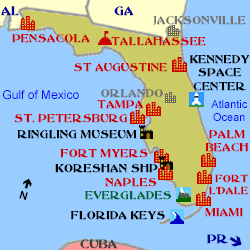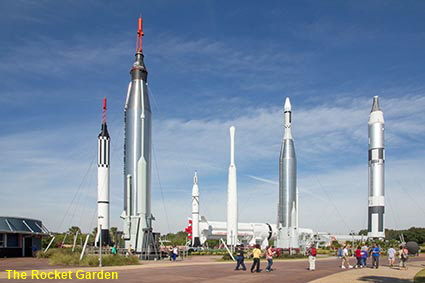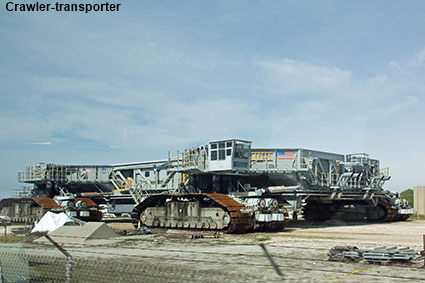Kennedy Space Center
In 1949 a facility was set up at Cape Canaveral in Florida for testing early long-range rockets. Nowadays in land adjacent to the early testing range stands the Kennedy Space Center, America’s one and only space port. We have visited twice, the first time back in 1982 the early days of the space shuttle when memories were relatively fresh of the huge rockets launching astronauts to the moon. There are more exhibits now plus a touch of the theme park glitz.
Saturn V Rocket
The extra weight of a lunar module meant that a rocket bigger than any to be seen in the Rocket Garden was needed to launch the Apollo missions to the moon. The giant Saturn V rocket was developed for this purpose. At the time when we first visited the Space Center this huge rocket was displayed on a transporter but now it is on a permanent base indoors in he Apollo/Saturn V Center which has more information on the astronauts and the machines that took them successfully to the moon and back. This picture is from our 1982 visit, the indoor display makes it impossible to get such a clear picture of this giant.
Crawler-transporter
The massive machines needed to lift payloads into space mean that everything at the Kennedy Space Center is big. The Vehicle Assembly building where orbiters are assembled is one of the largest buildings in the world, so tall that clouds can form inside it. Giant crawler-transporters like this one are used to move rockets (and formerly the space shuttle) from the Vehicle Assembly Building to the launch pads. Click Tab 2 to see the Vehicle Assemby Building.
The Rocket Garden
On arriving at the Kennedy Space Center our first port of call was the Visitor Center and the Rocket Garden next to it. It is a sobering thought that the technology behind these rockets was developed by Nazi Germany and used in V-2 bombs that they targeted on London in a desperate attempt to stop the Allies from winning World War 2. These Redstone, Atlas and Titan rockets were used for the more peaceful purpose of putting the early astronauts in space.

Click on Minimap to navigate
DLU170309


To move forwards or backwards through the Florida trail click the arrows above, or select your next destination on the Minimap.
Space Shuttle Atlantis
The idea of a reusable space vehicle that could carry payloads into low earth orbit then land back on earth like an aircraft dates back to the 1950s. Work to design what was then known as the Integrated Launch and Re-entry Vehicle (ILRV) began at the end of the 1960s. The space shuttle had four parts, the Orbiter (shown here) that carried the crew and payload, two solid fuel rocket boosters and an external liquid fuel tank. The solid fuel rockets provided most of the thrust in the early stages of the flight, then after 2 minutes they separated from the shuttle and parachuted back to earth to be recovered and reused. The external fuel tank was jettisoned when it was empty and burned up as it returned to earth, the only part of the shuttle that was not reused. Five shuttles were built and they were named Columbia, Challenger, Discovery, Atlantis and Endeavour. Columbia was the first to be launched on April 12, 1981 while Atlantis, the shuttle in this picture, was the last to fly in July 2011. Sadly the programme was marred by two disasters each of which cost the lives of all on board. On January 28, 1986, Challenger broke apart 73 seconds into its flight. It was discovered that extreme cold had caused the failure of a rubber O ring that sealed a joint in a solid fuel rocket. On February 1, 2003 Columbia disintegrated over Texas and Louisiana as it re-entered Earth's atmosphere. The cause was foam insulation that broke off the liquid fuel tank during launch which damaged the heatshield of the orbiter. Despite these two terrible tragedies, the five space shuttles completed a total of 133 successful missions.


© Mike Elsden 1981 - 2025
The contents of this page may not be reproduced in full or in part without permission


